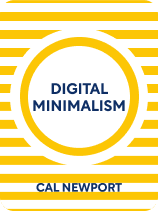

This article is an excerpt from the Shortform book guide to "Digital Minimalism" by Cal Newport. Shortform has the world's best summaries and analyses of books you should be reading.
Like this article? Sign up for a free trial here .
Do you feel you have control over your technology use? Is technology addiction a real phenomenon? Why do you think people get addicted to technology?
Most people, including you, probably spend more time on devices than they intend to. But technology addiction is a byproduct of the way human attention works. Tech companies are aware of it and they use it to engineer their products to keep people’s attention for as long as possible.
Keep reading to learn about psychology behind technology addiction.
Technology Addiction
Technology addiction is insidious. When social media and smartphones were first introduced, neither the creators nor the users had any idea that the technologies would evolve to become the ever-present, addictive forces they are today. The technologies transformed daily life and culture accidentally and unexpectedly.
When Facebook launched in 2004, people signed up for the service to keep in touch with friends and family. Similarly, when Apple released the first iPhone in 2007, Steve Jobs promoted it as a hybrid of a cell phone and an iPod—in fact, Jobs initially rejected suggestions to frame the iPhone as a small, ultra-mobile computer. As people spent more time using these digital tools, their usefulness morphed from convenient ways to stay connected to constant distractions pulling your attention away from the person sitting in front of you.
Today, many people spend hours on their devices, scrolling through their news feeds and compulsively checking emails. If you ask people how much time is a reasonable amount to spend on these activities, their answer would probably be less than the amount of time they actually spend. Where’s the disconnect? Why are people spending more time and energy on devices than they think they should?
The answer: Tech companies carefully engineer their products to keep your attention for as long as possible, because the longer your eyeballs are glued to the screen—where advertisements are placed strategically among your friend’s cat videos—the higher their revenues. This is the attention economy. You’re not lazy or indulgent, you’re simply falling victim to clever design tactics.
Technology overuse causes a number of negative effects, such as:
- Taking you away from other activities, either by eating up your time and leaving no opportunity to do other things, or by constantly pulling your attention to your device while you’re doing other things
- Decreasing your psychological well-being
- Bombarding you with negative and extreme content, because that kind of material attracts and sustains attention better than positive content
Above all, technologies’ addictive designs rob you of your autonomy to decide how and how much you use your digital tools. Digital minimalism can help you reclaim the power to decide how you allocate your time and attention—because, if you don’t feel that you have control over your own digital habits, then you become a victim of their negative consequences. However, just as smokers know that cigarettes cause cancer, simply understanding the consequences of technology overuse isn’t enough to help you escape its grasp. First, you need to understand how technology has caught you in its attention trap.
Technologies Use Addictive Designs
Although compulsively checking your Twitter feed may seem like a far cry from drug addiction, the two are more closely related than you think. In psychological terms, addiction means that you continue to do something that makes you feel good or provides some other reward, despite the negative consequences. In recent years, psychology experts have recognized that behavioral addictions—like gambling and internet addictions—can strongly resemble addictions to substances like drugs and alcohol.
In 2013, Adam Alter—a marketing professor with a PhD in social psychology—discovered firsthand the addictive effects of technology. Alter was boarding a cross-country flight, and he intended to spend the time catching up on sleep and work. Instead, he spent the entire six hours playing a game on his cell phone. Realizing what he’d done, Alter decided to investigate the psychological reasons that technology is addictive.
As Alter researched the topic, he discovered that digital tools are specifically designed to promote addiction in order to support the attention economy. Of the various features that encourage technology addiction—which Alter discusses in his 2017 book, Irresistible—we’ll explore two: intermittent positive reinforcement and the drive for social approval.
Feature #1: Intermittent Positive Reinforcement
Principle: When you get unpredictable rewards for your behavior, you’re more driven to continue that behavior than if the rewards were consistent.
Explanation: Your brain releases the craving-inducing chemical dopamine whenever you get a reward. When rewards are intermittent instead of reliable, your brain actually releases a larger amount of dopamine. For example, if you’re playing the slot machine, you pull the lever consistently, but you only win occasionally. Something about that unpredictability makes it more exciting—you keep pulling the lever not in spite of the unpredictability, but because of it.
In the 1970s, psychologist Michael Zeiler illustrated this principle in an experiment in which pigeons had to peck at a button in order to receive food pellets. When the pellets were released intermittently, the pigeons pecked more often than when the pellets were released predictably.
Technology application: On social media, the “Like” button is one form of intermittent reward. When you post a photo on Facebook, you may get a swarm of likes and comments, or you may get none. That uncertainty creates an urge for you to compulsively check your notifications, anxiously hoping to see more likes.
Technology companies also sprinkle rewards throughout their apps and websites, giving users sporadic hits of dopamine in order to keep them engaged longer. Think of a time when you visited a website for a specific purpose, and 30 minutes later you realize that you’d followed links and headlines down a rabbit hole of unrelated content—many of the articles and videos were uninteresting, but along the way you encountered a few that really engaged you. Those few interesting articles were rewards in your journey of distraction.
It’s clear that these features were deliberately designed in order to keep users’ attention, because early versions of apps and websites didn’t have these elements—they were added only after tech companies adopted their attention economy business models. Additionally, these features add no real value: Most Facebook users say that the benefit of the platform is to stay up-to-date with friends and family, and that would still be possible if Facebook disabled likes and comments.
Feature #2: The Drive for Social Approval
Principle: Humans are wired to seek social approval.
Explanation: In ancient times, people’s survival literally depended on being in good standing with the fellow members of their tribes. Modern humans’ brains still have the drive to seek and reciprocate social approval.
Technology application: On social media, likes and comments convey social approval. Your ancient social urges push you to compulsively check your notifications to find out whether your peers have validated you with the thumbs-up button—and, when you don’t get that feedback, you feel rejected and distressed by the lack of approval. That distress intensifies the urge to check your notifications in hopes of getting a like or a comment, creating a vicious cycle.
This is the reason that many teenagers get caught up in a stream of back-and-forth messages with their friends on Snapchat, because it feels like affirmation of their strong relationship. Similarly, this drive creates the urge to respond to a text message as soon as you hear your phone ping—regardless of whether you’re driving or sitting in a work meeting. To the ancient parts of your brain, ignoring a text or breaking a Snapchat streak is like giving your friend the cold shoulder, which could have serious implications in the context of a small tribe.
Human’s drive for social approval is also behind the photo-tagging option in social media apps like Facebook and Instagram. When you get a notification that someone tagged you in a photo, it feels like a message that the other person is thinking about you, which feeds your need for social approval and gives you an emotional boost. Social media companies have made it easier to trigger this response by using face-recognition technology and algorithms that identify other people in a photo and suggest that you tag them. When you post a photo of you and your friend, the app recognizes your friend’s face and prompts you to tag her with a single click. It takes minimal time and effort for the person who posts the photo, but it brings major psychological rewards for the person who gets tagged.

———End of Preview———
Like what you just read? Read the rest of the world's best book summary and analysis of Cal Newport's "Digital Minimalism" at Shortform .
Here's what you'll find in our full Digital Minimalism summary :
- Why you're addicted to technology (and how tech companies feed your addictions)
- How a focus on social media is bad for real-life relationships
- How to transform your tech habits to get the best benefits without the drawbacks






